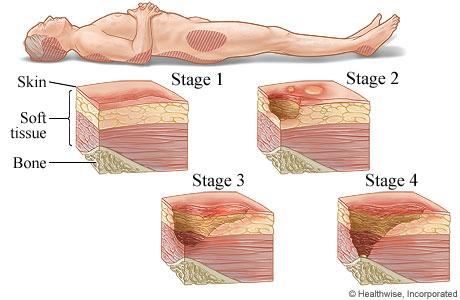A nurse assesses a patient who is admitted for treatment of fluid overload. Which manifestations does the nurse expect to find? (Select all that apply.)
Increased pulse rate
Decreased blood pressure
Skeletal muscle weakness
Warm and pink skin
Distended neck veins
Correct Answer : E
A. Increased pulse rate:
This is a common manifestation of fluid overload. Excess fluid volume can lead to an increase in cardiac output, causing the heart to pump faster and resulting in an increased pulse rate.
B. Decreased blood pressure:
Fluid overload typically leads to increased blood volume, which can initially cause an increase in blood pressure. However, as fluid overload progresses, it can lead to fluid redistribution, venous congestion, and decreased systemic vascular resistance, ultimately resulting in decreased blood pressure.
C. Skeletal muscle weakness:
Skeletal muscle weakness is not a direct manifestation of fluid overload. It is more commonly associated with electrolyte imbalances, such as hypokalemia or hypomagnesemia, which can occur as a consequence of fluid shifts but are not specific to fluid overload itself.
D. Warm and pink skin:
Warm and pink skin is not typically associated with fluid overload. Instead, it is more indicative of adequate tissue perfusion and oxygenation. In fluid overload, skin changes may include edema, cool and clammy skin due to venous congestion, or signs of skin breakdown in areas of pressure.
E. Distended neck veins:
Distended neck veins, specifically jugular venous distention (JVD), are commonly seen in patients with fluid overload, especially if there is right-sided heart failure or increased central venous pressure. JVD is a result of increased venous return to the heart due to fluid accumulation.
Nursing Test Bank
Naxlex Comprehensive Predictor Exams
Related Questions
Correct Answer is D
Explanation
A. Stage III pressure injury
Stage III pressure injuries involve full-thickness skin loss, extending into the subcutaneous tissue but not through the fascia. These wounds typically present as deep craters and may involve undermining or tunneling. Non-blanchable erythema alone without visible skin loss is not characteristic of a Stage III pressure injury.
B. Stage IV pressure injury
Stage IV pressure injuries are the most severe and involve full-thickness tissue loss with exposed bone, tendon, or muscle. These wounds often have extensive tissue damage and can be difficult to manage. Again, non-blanchable erythema without visible skin loss is not indicative of a Stage IV pressure injury.
C. Stage II pressure injury
Stage II pressure injuries involve partial-thickness skin loss with damage to the epidermis and possibly the dermis. These wounds often present as shallow open ulcers or blisters and may have characteristics such as intact or ruptured blisters. While Stage II injuries can present with erythema, non-blanchable erythema specifically indicates a Stage I injury.
D. Stage I pressure injury
Stage I pressure injuries are the earliest stage and involve non-blanchable erythema of intact skin. The skin may be warmer or cooler than surrounding tissue and may have changes in sensation. There is no visible skin loss at this stage, but the area is at risk for further injury if pressure is not relieved. Therefore, non-blanchable erythema on the heels most likely indicates a Stage I pressure injury.

Correct Answer is A
Explanation
A. Urine output is greater than 0.5 mL/kg/hr
During the fluid resuscitation phase of burn management, one of the primary goals is to maintain adequate tissue perfusion and organ function by ensuring sufficient fluid intake. The best method for assessing the results of fluid resuscitation is by monitoring urine output. A urine output of greater than 0.5 mL/kg/hr is indicative of adequate renal perfusion and kidney function, suggesting that fluid resuscitation is effective in maintaining tissue perfusion and preventing complications such as acute kidney injury.
B. Serum hemoglobin is 11 gm/dL
Serum hemoglobin levels can be affected by various factors, including fluid resuscitation, blood loss, and other medical conditions. While monitoring hemoglobin levels is important in overall patient assessment, it is not the best method specifically for assessing the results of fluid resuscitation during the initial phase of burn management.
C. Breath sounds are clear bilaterally
Clear bilateral breath sounds indicate adequate lung function and ventilation but may not directly reflect the effectiveness of fluid resuscitation in maintaining tissue perfusion. Lung sounds can be influenced by factors such as lung injury from smoke inhalation or mechanical ventilation settings, which may not correlate directly with fluid resuscitation outcomes.
D. Heart rate is 122/min
Heart rate can be influenced by various factors such as pain, stress, medications, and underlying medical conditions. While monitoring heart rate is important in assessing patient status, it is not the most reliable method for specifically evaluating the results of fluid resuscitation during the fluid resuscitation phase of burn management.
Whether you are a student looking to ace your exams or a practicing nurse seeking to enhance your expertise , our nursing education contents will empower you with the confidence and competence to make a difference in the lives of patients and become a respected leader in the healthcare field.
Visit Naxlex, invest in your future and unlock endless possibilities with our unparalleled nursing education contents today
Report Wrong Answer on the Current Question
Do you disagree with the answer? If yes, what is your expected answer? Explain.
Kindly be descriptive with the issue you are facing.
